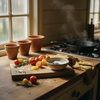Mixing Spoon Secrets: Essential Tools For Perfect Baking
Your mixing spoon might seem like the most basic tool in your kitchen drawer, but here's the thing—it's actually the unsung hero of every great dish you've ever made. A mixing spoon is a versatile kitchen utensil designed for stirring, blending, folding, and combining ingredients, and choosing the right one can make the difference between a recipe disaster and culinary triumph.
Whether you're whisking up a delicate soufflé or tackling your grandmother's legendary cookie dough, the right mixing spoon transforms kitchen chaos into pure magic.
Key Takeaways
- A mixing spoon is a versatile kitchen tool essential for stirring, blending, folding, and combining ingredients.
- Choosing the right mixing spoon can determine the success or failure of a recipe.
- The mixing spoon plays a crucial role in creating both delicate and hearty dishes.
- Using the proper mixing spoon helps transform cooking challenges into culinary triumphs.
Table of Contents
- The Essential Role of a Mixing Spoon in Your Kitchen Arsenal
- The Anatomy of a Perfect Mixing Spoon
- Versatility: One Tool, Many Tasks
- Design Innovations for the Modern Kitchen
- Choosing the Right Mixing Spoon for Baking Success
- Mixing Techniques: How Your Tool Affects Performance
- Maintenance and Care: Maximizing Your Investment
- Comparing Mixing Spoon Options: What Sets the Best Apart
- Choosing the Perfect Mixing Spoon for Your Kitchen
- Integrating Your Mixing Spoon into Your Kitchen Ecosystem
- Troubleshooting Common Mixing Challenges
- Advanced Mixing Techniques for Professional Results
- Sustainable Baking: Making Environmentally Conscious Tool Choices
Think about it: how many times have you watched a plastic spoon bend under the pressure of thick brownie batter, or worse, melt into your simmering sauce? We've all been there, and it's exactly why understanding what makes a great mixing spoon matters more than you might think.
The Essential Role of a Mixing Spoon in Your Kitchen Arsenal
Every memorable meal starts with proper mixing, and that's where your trusty mixing spoon steps into the spotlight. From the gentle folding required for fluffy pancakes to the vigorous stirring needed for homemade caramel, this humble tool handles it all with grace—if you've chosen the right one.
In professional kitchens, chefs rely on their mixing spoons like artists rely on their brushes. The tool becomes an extension of their hand, allowing them to feel the texture of their batter, gauge the consistency of their sauce, and control the incorporation of delicate ingredients. Home cooks deserve that same level of precision and reliability.
A quality mixing spoon for baking goes beyond simple stirring. It's your go-to for creaming butter and sugar, folding chocolate chips into cookie dough without overmixing, and scraping every last bit of precious batter from your bowl. The best mixing spoons multitask beautifully—they stir, scrape, fold, and serve, making them indispensable for anyone who takes their baking seriously.
The Anatomy of a Perfect Mixing Spoon

Not all mixing spoons are created equal, and understanding what separates the great ones from the mediocre makes all the difference in your cooking experience. Let's break down the features that transform a basic utensil into a kitchen powerhouse.
Ergonomic Design: Where Comfort Meets Performance
Your mixing spoon should feel like it was made for your hand, not against it. The best designs feature handles that provide a secure, comfortable grip even during extended mixing sessions. Think about those marathon cookie-baking days during the holidays—your hand shouldn't cramp up after mixing the third batch of dough.
Ergonomic handles are typically shaped with subtle curves and textured grips that prevent slipping, even when your hands are covered in flour or butter. The weight distribution matters too; a well-balanced mixing spoon reduces hand fatigue and gives you better control over your mixing technique.
Material Matters: The Foundation of Durability
Here's where things get interesting. The material of your mixing spoon determines not just how long it'll last, but how it performs in different cooking scenarios. High-grade silicone has become the gold standard for serious home cooks, and for good reason.
Premium silicone mixing spoons offer the perfect balance of flexibility and strength. They're gentle enough for your non-stick pans but sturdy enough to handle thick batters and doughs. Many feature reinforced cores—often made from nylon or stainless steel—that prevent bending and twisting under pressure.
The beauty of quality silicone lies in its heat resistance. While cheap plastic spoons start melting around 200°F, professional-grade silicone can handle temperatures up to 450°F or higher. This means you can stir your simmering jam, mix hot ingredients, and even use it for light sautéing without worry.
Heat Safety: Cooking with Peace of Mind
Temperature resistance isn't just a nice-to-have feature—it's essential for kitchen safety and versatility. The best mixing spoons maintain their shape and integrity even when exposed to high heat, protecting both your food and your cookware.
But heat resistance goes beyond just not melting. Quality materials won't leach chemicals or flavors into your food, even at high temperatures. This is particularly important when you're working with acidic ingredients like tomato sauce or citrus-based batters, which can cause inferior materials to break down.
Versatility: One Tool, Many Tasks
The most valuable kitchen tools are those that earn their drawer space by doing multiple jobs exceptionally well. A great mixing spoon isn't just for mixing—it's your scraper, your folder, your stirrer, and sometimes even your serving spoon.
For baking enthusiasts, this versatility is particularly valuable. You can use the same spoon to cream butter, fold in delicate ingredients, scrape down bowl sides, and transfer batter to your pan. The seamless transition between tasks keeps your workflow smooth and reduces the pile of dishes in your sink.
The gentle nature of silicone makes it perfect for non-stick surfaces, so you can confidently stir scrambled eggs in your favorite pan without leaving scratches. This protective quality extends the life of your cookware while giving you the freedom to use your mixing spoon across all your cooking adventures. If you're looking to further protect and complement your kitchen tools, you might also be interested in our best cooking utensils guide.
Design Innovations for the Modern Kitchen
Today's mixing spoons incorporate thoughtful design elements that make cooking more enjoyable and efficient. Space-saving features like nesting capabilities help organize cluttered drawers, while specialized shapes optimize performance for specific tasks.
Some innovative designs combine multiple tools into one, such as mixing spoons that pair with matching carafes or bowls. These combination products not only save storage space but also ensure perfect compatibility between your tools.
Storage and Organization Solutions
Kitchen real estate is precious, and the best mixing spoons acknowledge this reality. Nesting designs allow multiple spoons to stack together, taking up minimal drawer space while keeping your tools organized and accessible.
Look for spoons with hanging loops or stands that keep them within easy reach while cooking. Some designs even include magnetic strips or hooks that attach to your refrigerator or backsplash, turning your tools into functional kitchen décor.
The evolution of the humble mixing spoon reflects our changing relationship with cooking—we want tools that work harder, last longer, and make our time in the kitchen more enjoyable. Whether you're a weekend baker or a daily cooking enthusiast, investing in a quality mixing spoon pays dividends in every dish you create.
Choosing the Right Mixing Spoon for Baking Success

Baking is a science, and like any good scientist, you need the right tools to achieve consistent, repeatable results. The mixing spoon you choose can make or break your baking game—literally. Ever tried folding delicate meringue with a heavy wooden spoon? It's like trying to paint watercolors with a house brush.
When selecting a mixing spoon for baking, consider the types of batters and doughs you work with most. Thick cookie doughs demand strength and durability, while delicate cake batters require a gentle touch. The best baking mixing spoons strike that perfect balance between sturdy enough for heavy work and flexible enough for finesse.
Size matters too. A spoon that's too small will have you stirring forever, while one that's too large won't give you the control needed for precise techniques. Look for mixing spoons with heads that are proportioned to fit comfortably in standard mixing bowls while providing enough surface area for efficient mixing.
The Professional-Grade Silicone Advantage
Here's where DI ORO's expertise really shines. Our pro-grade silicone mixing spoons are engineered for serious bakers who refuse to compromise on quality or safety. Made with LFGB-certified silicone that's completely free of forever chemicals, these tools give you peace of mind along with professional performance.
The heat resistance of quality silicone means you can confidently work with warm ingredients—think melted chocolate, warm milk for yeast activation, or hot sugar syrups—without worrying about your tool failing at the crucial moment. At 600°F heat resistance, DI ORO mixing spoons handle whatever your recipes throw at them. For bakers looking to invest in top-tier kitchen tools, explore our Mix & Measure mixing spatulas collection for durable, high-performance options.
But it's not just about heat. The non-reactive nature of premium silicone means your mixing spoon won't absorb flavors, odors, or stains. Your vanilla cake batter won't taste like last night's garlic sauce, and your white chocolate won't pick up unwanted colors from previous mixing sessions.
Mixing Techniques: How Your Tool Affects Performance
Different baking techniques require different approaches, and your mixing spoon should adapt to your needs, not force you to adapt to its limitations. Let's explore how the right mixing spoon enhances specific baking techniques.
Folding Technique Mastery
Folding is perhaps the most delicate mixing technique in baking, used to incorporate ingredients without deflating air bubbles that create lightness in cakes, soufflés, and mousses. A proper mixing spoon for this technique needs flexibility to curve with your bowl and a thin edge that cuts through batter cleanly. For more in-depth guidance on folding, beating, and stirring, check out this authoritative guide to mixing methods.
The key is in the motion—a gentle scooping action that brings batter from the bottom up and over the top, rotating the bowl as you work. A stiff or overly thick mixing spoon disrupts this flow, potentially ruining hours of careful preparation. Quality silicone spoons flex just enough to follow the bowl's contours while maintaining their structural integrity.
Creaming: When You Need Mixing Power
Creaming butter and sugar is the foundation of countless baked goods, from cookies to cakes. This technique requires a mixing spoon that can handle resistance without bending or breaking. The repeated motion of pressing and stirring demands ergonomic design that prevents hand fatigue.
While many bakers reach for electric mixers for creaming, hand mixing gives you better control over texture and prevents overmixing. A reinforced mixing spoon with a comfortable grip makes this traditional technique accessible and enjoyable, connecting you to generations of bakers who perfected these recipes by hand.
Maintenance and Care: Maximizing Your Investment
A quality mixing spoon should be a lifetime companion in your kitchen adventures, but proper care ensures it stays that way. The beauty of premium silicone mixing spoons lies not just in their performance, but in their incredibly low maintenance requirements.
Dishwasher safety is non-negotiable for busy home bakers. After a day of cookie production or cake decorating, the last thing you want is hand-washing a collection of mixing tools. Quality silicone spoons emerge from the dishwasher looking brand new, with no warping, discoloration, or degradation.
For hand washing, warm soapy water and a gentle scrub are all you need. The non-stick properties of good silicone mean even the stickiest batters release easily. Stubborn residues from chocolate or caramel dissolve with minimal effort, making cleanup almost as satisfying as the baking itself. If you're interested in cleaning and maintaining other essential kitchen tools, read our post on how to cook eggs on stainless steel for extra tips.
Storage Best Practices
Proper storage extends the life of your mixing spoons and keeps them ready for action. Avoid cramming them into overcrowded drawers where they can get scratched or deformed. Instead, designate a specific spot where they can lie flat or hang freely.
Some bakers prefer countertop canisters that keep frequently used tools within arm's reach. Others opt for drawer organizers that separate tools by function. Whatever system you choose, ensure your mixing spoons aren't pressed against sharp objects or subjected to extreme temperatures during storage.
Comparing Mixing Spoon Options: What Sets the Best Apart

The mixing spoon market offers everything from dollar-store basics to professional-grade tools, but understanding what justifies the price difference helps you make informed decisions. Cheap mixing spoons might seem economical initially, but they often fail when you need them most—right in the middle of your holiday baking marathon.
Premium mixing spoons like those from DI ORO represent a different philosophy entirely. These tools are designed to perform consistently over years of regular use, backed by warranties that demonstrate the manufacturer's confidence in their durability. When America's Test Kitchen recognizes your spatulas and mixing tools, you know you're dealing with serious quality.
The difference becomes apparent in daily use. Premium spoons maintain their shape under pressure, resist staining and odor absorption, and provide the tactile feedback that experienced bakers rely on. They're tools that grow with your skills, supporting you whether you're making simple cookies or attempting complex pastries. If you're looking to round out your kitchen with other useful accessories, browse our complete kitchen tools collection.
The Value Proposition of Quality Tools
Investing in a high-quality mixing spoon isn't just about immediate performance—it's about long-term value and cooking enjoyment. When you calculate the cost per use over several years, premium tools often prove more economical than repeatedly replacing cheaper alternatives.
But the real value lies in the confidence these tools provide. Knowing your mixing spoon won't fail, melt, or break during critical moments allows you to focus on technique and creativity rather than worrying about equipment failure. This peace of mind is invaluable when you're preparing special occasion desserts or trying challenging new recipes.
Quality mixing spoons also contribute to better results. Consistent performance leads to consistent outcomes, helping you develop your skills and build confidence in the kitchen. When your tools work reliably, you can focus on perfecting your techniques and expanding your baking repertoire.
The journey from novice baker to confident home chef is supported by tools that rise to meet your growing ambitions. A professional-grade mixing spoon becomes an extension of your hand, translating your intentions into perfectly mixed batters, properly folded ingredients, and ultimately, memorable meals that bring people together around your table. To further enhance your kitchen skills, you might enjoy our article on choosing and using cooking tongs for greater versatility.
Choosing the Perfect Mixing Spoon for Your Kitchen
With so many options flooding the market, selecting the right mixing spoon can feel overwhelming. But here's the truth: the perfect mixing spoon isn't necessarily the most expensive one—it's the one that matches your cooking style, kitchen habits, and quality standards. Think of it as finding your culinary soulmate, but with better heat resistance.
Start by honestly assessing your baking frequency and ambitions. Weekend warriors who tackle elaborate layer cakes need different tools than everyday bakers making quick muffins for school lunches. However, don't underestimate your potential—many home bakers find that quality tools actually inspire them to attempt more challenging recipes.
Consider your physical comfort too. If you have arthritis or hand fatigue issues, ergonomic design becomes crucial. The best mixing spoon in the world won't help if it's uncomfortable to use for extended periods. Look for handles that feel natural in your grip and heads that provide efficient mixing without requiring excessive force.
Material Considerations for Optimal Mixing Performance
The material of your mixing spoon affects everything from durability to food safety. Wood, while traditional and aesthetically pleasing, can harbor bacteria and absorb flavors over time. Plastic options vary wildly in quality, with cheaper versions prone to melting, staining, and breaking under pressure.
Stainless steel offers durability but can scratch non-stick surfaces and conduct heat uncomfortably during warm ingredient preparation. This is where premium silicone truly shines—it combines the best attributes of other materials while eliminating their drawbacks.
Pro-grade silicone mixing spoons provide the flexibility needed for gentle folding, the strength required for heavy mixing, and the heat resistance essential for versatile cooking. When that silicone is also free from forever chemicals and LFGB certified, you're investing in both performance and health—a combination that's hard to beat. To see how top kitchen experts approach mixing methods, read this detailed resource on different mixing methods and their importance.
Integrating Your Mixing Spoon into Your Kitchen Ecosystem
Your mixing spoon doesn't exist in isolation—it's part of a larger kitchen ecosystem that should work harmoniously together. Consider how your mixing spoon interacts with your bowls, measuring cups, and other tools. A spoon that's too large for your favorite mixing bowls creates frustration, while one that's too small makes efficient mixing nearly impossible.
Think about your storage solutions too. If you're working with limited drawer space, a mixing spoon that nests with other tools or hangs easily might be preferable. Some bakers prefer having multiple mixing spoons in different sizes, dedicating specific tools to sweet versus savory preparations.
The cleaning routine also matters. If you're someone who prefers hand-washing delicate items, ensure your mixing spoon cleans easily without requiring special care. For dishwasher devotees, verify that your chosen spoon can handle repeated high-heat cycles without degrading.
Building Your Mixing Spoon Collection
Many serious bakers eventually develop a collection of mixing spoons, each optimized for specific tasks. A large spoon for bread doughs, a medium one for cake batters, and a smaller precision tool for delicate work. This isn't kitchen gadget excess—it's strategic tool selection that improves your baking outcomes.
Start with one high-quality, versatile mixing spoon that handles 80% of your baking tasks. As your skills and ambitions grow, you can add specialized tools that address specific needs. This approach prevents drawer clutter while ensuring you always have the right tool for the job.
Quality over quantity remains the guiding principle. Three exceptional mixing spoons will serve you better than a dozen mediocre ones. When you invest in tools that perform reliably and last for years, you're building a foundation for countless successful baking adventures.
Troubleshooting Common Mixing Challenges

Even with the right mixing spoon, certain baking challenges can trip up home cooks. Understanding how your tool contributes to solutions helps you work more efficiently and achieve better results. Let's address some common mixing dilemmas and how the right spoon makes all the difference.
Overmixing is perhaps the most frequent mistake in baking, leading to tough muffins, dense cakes, and chewy cookies. A quality mixing spoon provides the tactile feedback needed to recognize when your batter reaches the perfect consistency. You'll feel the resistance change as gluten develops, allowing you to stop mixing at the optimal moment.
Uneven mixing creates pockets of flour or sugar that ruin texture and appearance. This often happens when bakers use tools that don't efficiently move ingredients throughout the bowl. A well-designed mixing spoon with the right head shape ensures thorough incorporation without overworking the batter. For more help on mastering liquid ingredients, you may also find value in our guide to liquid measuring cups.
Temperature-Sensitive Mixing Solutions
Temperature control during mixing affects everything from chocolate tempering to butter incorporation. A heat-resistant mixing spoon allows you to work confidently with warm ingredients, maintaining optimal temperatures without tool failure. This capability expands your recipe possibilities significantly.
Cold ingredient mixing presents different challenges. Firm butter, chilled cream, and cold eggs require tools that won't crack or become brittle in low temperatures. Premium silicone maintains its flexibility across temperature extremes, ensuring consistent performance regardless of ingredient temperature.
Understanding these temperature interactions helps you choose mixing techniques that complement your ingredients' natural properties. The right mixing spoon becomes an extension of your understanding, translating knowledge into perfect execution.
Advanced Mixing Techniques for Professional Results
As your confidence grows, advanced mixing techniques become accessible with the right tools. Techniques like ribbon stage mixing for genoise, proper macaron macaronage, and temperature-controlled chocolate incorporation require precision that only quality tools can provide.
The ribbon stage—where batter falls from your spoon in a continuous ribbon that briefly holds its shape—requires a mixing spoon that provides clear visual and tactile cues. Cheap tools often lack the necessary flexibility and feedback, making it difficult to recognize this crucial stage.
Macaronage, the delicate folding technique used in macaron making, demands a tool that can deflate the meringue just enough while maintaining the necessary structure. Too aggressive, and your macarons won't rise properly. Too gentle, and they won't develop the characteristic smooth tops. For more on the science behind mixing and its effect on baking results, you can read this in-depth article on mixing methods.
Precision Mixing: Professional Techniques at Home
Professional bakers rely on specific mixing techniques that home cooks can master with proper tools and practice. The "well method" for combining wet and dry ingredients, the "creaming method" for optimal butter incorporation, and "reverse creaming" for tender cakes all benefit from tools designed for precision.
These techniques aren't just professional showing off—they produce measurably better results. When you have a mixing spoon that responds predictably to your movements, you can focus on perfecting these methods rather than fighting your equipment.
The investment in quality tools pays dividends as your skills develop. What seems like a simple mixing spoon becomes a precision instrument that helps you achieve professional-level results in your home kitchen.
Sustainable Baking: Making Environmentally Conscious Tool Choices
Modern home bakers are increasingly mindful of their environmental impact, making durable, safe kitchen tools a smart choice. A high-quality, forever-chemical-free silicone mixing spoon is not only healthier but also more sustainable than disposable, low-quality alternatives. Premium silicone can often be recycled and, unlike composite materials, won't release harmful toxins—making it a better option for both you and the planet.
DI ORO’s durable tools, backed by lifetime replacement guarantees, reflect a commitment to longevity and reduced waste. The right mixing spoon becomes more than just a utensil—it’s a reliable partner in your baking journey, helping you perfect everything from delicate meringues to cookie dough. Choose tools that last, perform better, and support a more sustainable kitchen.
Frequently Asked Questions
What is a mixing spoon used for?
A mixing spoon is designed to blend ingredients smoothly and evenly, whether you’re stirring batter, sauces, or cocktails. Its shape and length allow you to reach deep into bowls or pots, ensuring thorough mixing without splashing. It’s a versatile kitchen tool that helps create consistent textures and flavors in your culinary creations.
What is also called a mixing spoon?
A mixing spoon is sometimes referred to as a stirring spoon or a wooden spoon, especially when made from wood. In bartending, it may be called a bar spoon, which is specifically designed for mixing drinks. While the terms overlap, each can have slight variations depending on the context and material.
Why are mixing spoons twisted?
Mixing spoons are often twisted to improve their efficiency in stirring and layering liquids. The twisted handle allows for better grip and control, while the spiral shape helps ingredients blend smoothly by creating a gentle vortex. This design is especially popular in bar spoons where precision and speed matter.
What are stirring spoons called?
Stirring spoons can go by different names depending on their use and material, including mixing spoons, bar spoons, wooden spoons, or even paddle spoons. In professional kitchens and bars, the term 'bar spoon' is common for long, slender spoons used in cocktails, while 'wooden spoons' are staples in general cooking.
Why are bartender spoons so long?
Bartender spoons are long to reach deep into tall glasses or mixing tins, making it easier to stir cocktails thoroughly without splashing. The length also provides leverage for flipping and layering drinks with precision. This extended design keeps your hands away from the liquid, ensuring a clean and professional pour every time.
What is a jigger for?
A jigger is a small measuring tool used in bartending to pour precise amounts of liquid ingredients, typically spirits. It ensures recipe accuracy and consistency in cocktails, helping you balance flavors perfectly. Most jiggers have two sides with different measurements, making it a quick and easy way to measure shots without guesswork.
-
Posted in
mixing spoon for baking




